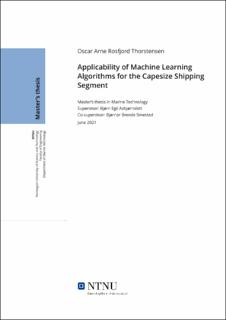| dc.contributor.advisor | Asbjørnslett, Bjørn Egil | |
| dc.contributor.advisor | Smestad, Bjørnar Brende | |
| dc.contributor.author | Thorstensen, Oscar Arne Rosfjord | |
| dc.date.accessioned | 2021-10-21T17:19:44Z | |
| dc.date.available | 2021-10-21T17:19:44Z | |
| dc.date.issued | 2021 | |
| dc.identifier | no.ntnu:inspera:78668897:25561779 | |
| dc.identifier.uri | https://hdl.handle.net/11250/2824599 | |
| dc.description.abstract | Denne avhandlingen undersøker anvendeligheten til utvalgte maskinlæringsalgoritmer for å kunne forutsi kortsiktige bevegelser i fraktrater ved Capesize-ruten mellom Tubarao og Qingdao (C3). Med et utgangspunkt i markedsstørrelse, potensial og anvendelighet for gjennomføring av en atferds studie, valgte vi å se på skipsfartssegmentet for tørr bulk til denne øvelsen. I et forsøk på å identifisere viktige elementer som påvirker Capesize bulk-operasjoner benyttet vi input fra Automatic Identification System (AIS) og annen markedsrelevant data. Det ble gjennomført en omfattende litteraturstudie for å undersøke relevansen av referansetemaet for målet med avhandlingen. Studien evaluerte tre ulike maskinlæringsmodeller; en linear ridge regression (LRR) modell, en random forest regression (RFR) modell, og en long short-term memory (LSTM) modell. En persistence model ble brukt til å sammenligne prognoseresultatene og for å etablere et ytelsesnivå. Til sist ble det brukt en grid search metode for å analysere og beskrive den mest gunstige kombinasjonen av hyperparametere ved de benyttede maskinlærings algoritmene. Resultatene våre indikerer at de utvalgte modellene viser evne til å kunne forutsi kortsiktige bevegelser i fraktraten til C3-ruten. Alle undersøkte funksjonssett inkluderte en kombinasjon av AIS og markedsavledede data og støttet følgelig målet av avhandlingen. Vi kan derfor konkludere med at maskinlæringsmodellene som ble brukt i denne studien til en viss grad kan forutsi kortsiktige bevegelser i fraktrater ved C3-ruten. | |
| dc.description.abstract | The thesis investigates the applicability of selected machine learning algorithms to predict short-term freight rate movements on the Capesize route from Tubarao to Qingdao (C3). The dry bulk shipping segment was selected for this exercise in consideration of its market size, potential and applicability to the performance of a behavioral study. Input from Automatic Identification System (AIS) and market-relevant data has been employed in attempts to identify significant elements (features) influencing Capesize bulk operations. A comprehensive literature review was conducted for benchmark topic relevance to the problem objective. The study has used AIS data retrieved from the Norwegian Coastal Administration (NCA) database as well as market derived information provided by Clarksons Platou. Several methods were explored in the process of extracting and constructing relevant features from the different data sources. In attempts to determine the more important influencing elements, different feature selection methods were utilized. The study considered three different machine learning models; (1) the linear ridge regression (LRR) model, (2) the random forest regression (RFR) model, and (3) the long short-term memory (LSTM) model. The persistence model was utilized for comparison purposes of the forecasting results and to provide a benchmark performance level. Lastly, the study employed a grid search method to analyze and describe the optimal combination of hyperparameters for the various employed machine learning algorithms. The results of the conducted investigation indicate that all selected models employed in this thesis show capabilities in predicting short-term freight rate movements on the C3 route. Differing sets of features proved influential in development of prediction accuracy in machine learning algorithms. However, results attained provided no definitive conclusions or identification as to which feature specification set that showed greatest market influence. All examined feature sets included a combination of AIS- and market-derived data and consequently supported the objective formulated for this thesis. We can therefore conclude that the employed machine learning models can to some degree predict short-term freight rate movements on the C3 route. | |
| dc.language | eng | |
| dc.publisher | NTNU | |
| dc.title | Applicability of Machine Learning Algorithms for the Capesize Shipping Segment | |
| dc.type | Master thesis | |
